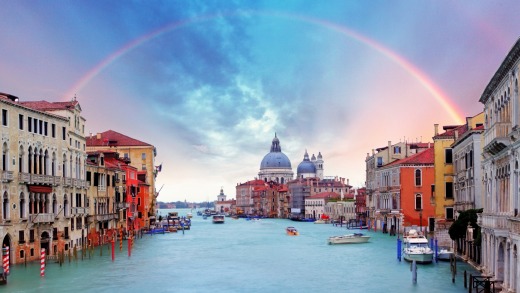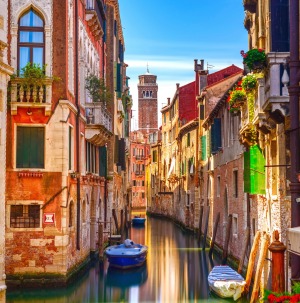Winter isn't exactly peak season for tourism in Venice - it's cold, deserted and often rainy - but that's exactly why you should go. Unlike the summer, when the sweltering city teems with millions of visitors, winter in Venice is tranquil, misty and blissfully quiet; La Serenissima at its finest. Still not convinced? Here are five reasons why you need to visit now.
From January 23 through February 9, the sleepy streets of Venice come alive for Carnevale—an annual open-air festival that fills the city with music, dancing, and masked party-goers. Key events take place in Piazza San Marco and the Arsenale, Venice's historic shipyard, though hotels and restaurants across the city host parties, feasts and masquerade balls throughout the duration of the festival. To make the most of your Carnevale experience, head to a traditional mascarei and get yourself a mask to wear during the festivities—or better yet, go all out and rent a costume at one of Venice's many ateliers (Pietro Longhi has an impressive collection). Travelling with kids? Don't miss the ice-skating rink in Campo San Polo, which exists only from December through to the end of Carnevale.
In summer, La Serenissima is anything but serene: it's stuffed to the gills with tourists who clog its bridges, swell its vaporetti and pack its landmarks from wall-to-wall. But in the chilly winter months, you'll have the bridges to yourself, drift along the Grand Canal on an empty vaporetto and stroll right into Saint Mark's Basilica - Italy's most famous Byzantine cathedral - without waiting in line. You can saunter freely through Venice's narrow alleyways, unhindered by the suffocating crush of map-wielding tourists, and choose any table you desire at the iconic Caffè Florian (order their rich, ganache-like hot chocolate). Sure, Venice is beautiful any time of year - but go now, while you have it all to yourself.

Being the off-season, there's no other time of year you can score five-star hotel rooms at two-star prices. At Venice's oldest hotel, Baglioni Hotel Luna, you can nab a deluxe room for as low as €270 ($A416) per night in January, compared to €490 in July. Same goes for the iconic Gritti Palace, located on the Grand Canal, where twin rooms are listed for €320 - almost half the price of the average nightly rate at peak season. Budget hotels like Hotel Casanova - located right off Piazza San Marco and a short walk from Saint Mark's Basilica and Doge's Palace - and are even offering rooms for as low as €54 per night, and you can find even better deals if you're willing to stay on the outer islands like Guidecca or Torcello.
You can ride a gondola any time of year, but winter is inarguably the most romantic (and relaxing) time to hop on board. From December through February, Venice's empty, mist-shrouded canals glisten in the soft, surreal winter light, like a real-life Federico Fellini film. Without the noisy waterway congestion and crooning gondoliere at every turn, riding a gondola in winter can be a calming and deeply luxurious experience. It's also cheaper: being low season, it's easier to broker a lower price with your gondoliere (you can likely knock €5–10 off the steep €80 average for a 30-minute ride).
In the summer, many restaurants in Venice cater to tourists, filling their menus with safe, crowd-pleasing dishes like spaghetti and margherita pizza. But in the winter, the Venetians reclaim their city and their cuisine, and menus fill again with rustic, traditional Venetian comfort food: white bean soup, creamy polenta with shrimp, hearty risottos and cuttlefish stew. For deeply authentic Venetian cooking that'll warm your belly (and soul), make a beeline for Vecio Fritolin in San Polo, or the cheap but delicious Alla Palanca on Guidecca island. Or simply duck into any small, cozy, well-lit osteria that's buzzing with locals—a great indication you'll find a good, hot, home-cooked meal inside.
